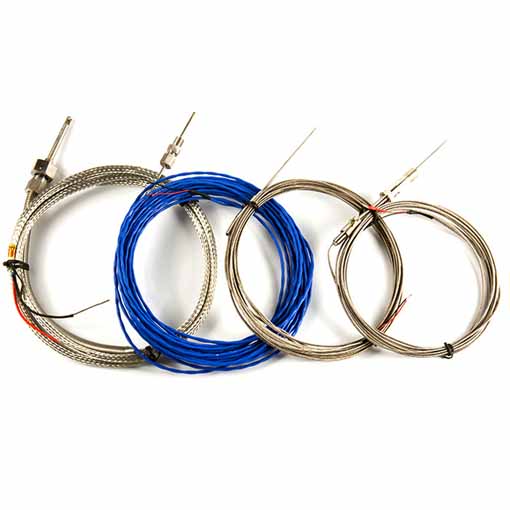หมวดหมู่สินค้า
- เบรกเกอร์ความร้อน 20
- ที่ยึดกล่องฟิวส์ 36
- เซ็นเซอร์อุณหภูมิ 67
- สวิตช์ความร้อน 64
- ฟิวส์รถยนต์ 19
- สลักเกลียวลงฟิวส์ 7
- ฟิวส์ความร้อน 32
- ฟิวส์ยึดพื้นผิว 12
- เทอร์มิสเตอร์ 22
- ตัวยึดฟิวส์ PCB Mount 27
- ชุดสายไฟ 6
- ตัวยึดฟิวส์ใบมีด 17
- เทอร์โมสตัท 46
- ฟิวส์ไฟฟ้า 14
แท็กสินค้า
ซัพพลายเออร์เทอร์โมคัปเปิลที่แม่นยำ
e โรงงานผลิตดั้งเดิมที่ผลิตขึ้น, J, เซ็นเซอร์เทอร์โมคัปเปิล T ใช้สำหรับการตรวจจับอุณหภูมิดังต่อไปนี้: เครื่องวัดอุณหภูมิ, เครื่องทำน้ำอุ่น, เตาผิง, เตาเผา, วงจร, RTD, ทางแยกเย็น, เตาอบ, มัลติมิเตอร์, ดิจิตอล, ทางอุตสาหกรรม.
หลักการทำงานของ E, J, เซ็นเซอร์เทอร์โมคัปเปิล :
เมื่อมีตัวนำที่แตกต่างกันสองตัวหรือเซมิคอนดักเตอร์ A และ B ที่แตกต่างกัน, ปลายทั้งสองซึ่งเชื่อมต่อกัน, ตราบใดที่อุณหภูมิของสองทางแยกนั้นแตกต่างกัน. อุณหภูมิที่ปลายด้านหนึ่งคือ T, เรียกว่าจุดสิ้นสุดการทำงานหรือปลายร้อน, และอุณหภูมิที่ปลายอีกด้านคือ T0, เรียกว่าตอนจบฟรี (เรียกอีกอย่างว่าปลายอ้างอิง) หรือปลายเย็น. แรงไฟฟ้าจะถูกสร้างขึ้นในวง. ทิศทางและขนาดของแรงไฟฟ้าที่เกี่ยวข้องกับวัสดุของตัวนำและอุณหภูมิของสองทางแยก. ปรากฏการณ์นี้เรียกว่า “ผลกระทบเทอร์โมอิเล็กทริก”, และวงที่ประกอบด้วยตัวนำสองตัวเรียกว่า “เทอร์โมคัปเปิล”. ตัวนำทั้งสองนี้เรียกว่า “เทอร์โมอิเล็กโทรด”, และแรงไฟฟ้าที่สร้างขึ้นเรียกว่า “แรงเทอร์โมอิเล็กทรอนิกส์”.
แรงเทอร์โมอิเล็กทรอนิกส์ประกอบด้วยแรงไฟฟ้าสองส่วน, ส่วนหนึ่งคือกำลังไฟฟ้าสัมผัสของตัวนำสองตัว, และอีกส่วนหนึ่งคือแรงเทอร์โมอิเล็กทรอนิกส์ของตัวนำเดียว.
ขนาดของแรงเทอร์โมอิเล็กทรอนิกส์ใน E, J, T thermocouple sensor loop มีความสัมพันธ์กับอุณหภูมิของวัสดุตัวนำเท่านั้นและทางแยกทั้งสองที่ประกอบขึ้นเป็นเทอร์โมคัปเปิล, และไม่มีส่วนเกี่ยวข้องกับรูปร่างและขนาดของเซ็นเซอร์เทอร์โมคัปเปิล. เมื่อวัสดุอิเล็กโทรดทั้งสองของเซ็นเซอร์เทอร์โมคัปเปิ้ลได้รับการแก้ไข, แรงเทอร์โมอิเล็กทรอนิกส์คือความแตกต่างของฟังก์ชั่นของอุณหภูมิทางแยกทั้งสอง t และ t0.
ซึ่งก็คือ:
ความสัมพันธ์นี้ถูกนำมาใช้อย่างกว้างขวางในการวัดอุณหภูมิจริง. เพราะทางแยกเย็น T0 เป็นค่าคงที่, แรงเทอร์โมอิเล็กทรอนิกส์ที่เกิดจาก E, J, t thermocouple เปลี่ยนเฉพาะอุณหภูมิของทางแยกร้อน (จุดสิ้นสุดการวัด), นั่นคือ, แรงเทอร์โมอิเล็กทรอนิกส์บางอย่างสอดคล้องกับอุณหภูมิที่แน่นอน. เราสามารถบรรลุวัตถุประสงค์ของการวัดอุณหภูมิตราบเท่าที่เราใช้วิธีการวัดแรงเทอร์โมอิเล็กโตรมิเตอร์.
หลักการพื้นฐานของการวัดอุณหภูมิเทอร์โมคัปเปิลคือตัวนำสองตัวของส่วนประกอบที่แตกต่างกันเป็นวงปิด. เมื่อมีการไล่ระดับอุณหภูมิที่ปลายทั้งสอง, จะมีกระแสผ่านลูป. ในเวลานี้, มีแรงไฟฟ้าแรง-เทอร์โมอิเล็กทรอนิกส์ระหว่างปลายทั้งสอง, ซึ่งเป็นเอฟเฟกต์ Seebeck ที่เรียกว่า. ตัวนำที่เป็นเนื้อเดียวกันสองตัวที่มีส่วนประกอบต่างกันคือ Thermoelectrodes, จุดจบที่มีอุณหภูมิสูงขึ้นคือจุดสิ้นสุดการทำงาน, จุดจบที่มีอุณหภูมิต่ำกว่าคือปลายอิสระ, และปลายอิสระมักจะอยู่ที่อุณหภูมิคงที่แน่นอน. ตามความสัมพันธ์ในการทำงานระหว่างแรงเทอร์โมอิเล็กโตรมิโตอิเล็กทรอนิกส์และอุณหภูมิ, ทำตารางดัชนีเทอร์โมคัปเปิล;
ตารางดัชนีจะได้รับเมื่ออุณหภูมิสิ้นสุดฟรีอยู่ที่ 0 ℃, และเซ็นเซอร์เทอร์โมคับเปิลที่แตกต่างกันมีตารางดัชนีที่แตกต่างกัน.
เมื่อวัสดุโลหะที่สามเชื่อมต่อในวงจรเทอร์โมคัปเปิล, ตราบใดที่อุณหภูมิของสองทางแยกของวัสดุก็เหมือนกัน, ศักยภาพของเทอร์โมอิเล็กทริกที่เกิดจากเทอร์โมคัปเปิลจะยังคงไม่เปลี่ยนแปลง. นั่นคือ, มันไม่ได้รับผลกระทบจากการเข้าถึงโลหะที่สามในลูป. ดังนั้น, เมื่อเทอร์โมคัปเปิลวัดอุณหภูมิ, เครื่องมือวัดสามารถเชื่อมต่อได้, และอุณหภูมิของตัวกลางที่วัดได้นั้นเป็นที่รู้จักหลังจากวัดแรงเทอร์โมอิเล็กโตรมิโต. เมื่อเทอร์โมคัปเปิลวัดอุณหภูมิ, อุณหภูมิของทางแยกเย็น (จุดสิ้นสุดการวัดคือจุดจบร้อน, และจุดสิ้นสุดที่เชื่อมต่อกับวงจรการวัดผ่านตะกั่วเรียกว่าทางแยกเย็น) จำเป็นต้องรักษาอุณหภูมิเท่ากัน. ศักยภาพของเทอร์โมอิเล็กทริกนั้นเป็นสัดส่วนกับอุณหภูมิที่วัดได้. ถ้า (สิ่งแวดล้อม) อุณหภูมิของทางแยกเย็นเปลี่ยนแปลงระหว่างการวัด, มันจะส่งผลกระทบต่อความแม่นยำของการวัดอย่างจริงจัง. ใช้มาตรการบางอย่างเพื่อชดเชยที่ทางแยกเย็น, และอิทธิพลที่เกิดจากการเปลี่ยนแปลงอุณหภูมิของทางแยกเย็นเรียกว่าการชดเชยทางแยกเย็นของเทอร์โมคัปเปิลเป็นเรื่องปกติ. ลวดชดเชยเฉพาะสำหรับการเชื่อมต่อกับเครื่องมือวัด.
วิธีการคำนวณของเซ็นเซอร์เทอร์โมคัปเปิลการชดเชยความเย็น:
จากมิลลิโวลต์ถึงอุณหภูมิ: วัดอุณหภูมิทางแยกเย็น, แปลงเป็นค่า Millivolt ที่สอดคล้องกัน, เพิ่มลงในค่า millivolt ของเทอร์โมคัปเปิล, และคำนวณอุณหภูมิ;
จากอุณหภูมิถึงมิลลิโวลต์: วัดอุณหภูมิที่แท้จริงของอุณหภูมิปลายเย็น, ตามลำดับ, ในแง่ของ Millivolts, หลังจากลบค่าที่ได้รับ MV, เพื่อให้ได้อุณหภูมิ.
e โรงงานผลิตดั้งเดิมที่ผลิตขึ้น, J, เซ็นเซอร์เทอร์โมคัปเปิล T ใช้สำหรับการตรวจจับอุณหภูมิดังต่อไปนี้: เครื่องวัดอุณหภูมิ, เครื่องทำน้ำอุ่น, เตาผิง, เตาเผา, วงจร, RTD, ทางแยกเย็น, เตาอบ, มัลติมิเตอร์, ดิจิตอล, ทางอุตสาหกรรม.

เส้นผ่านศูนย์กลางเทอร์โมคัปเปิลหุ้มเกราะ 3 มม. + ซ็อกเก็ตชนิด J

PT100 E, J, โพรบเซ็นเซอร์อุณหภูมิ

ลวดตรวจจับอุณหภูมิเทอร์โมคัปเปิลร้อน

เทอร์โมคัปเปิลที่อุณหภูมิสูง K-type
ติดต่อเรา
กำลังรออีเมลของคุณ, เราจะตอบกลับคุณภายใน 12 ชั่วโมงด้วยข้อมูลอันมีค่าที่คุณต้องการ.
 English
English العربية
العربية Български
Български 粤语
粤语 中文(简体)
中文(简体) 中文(漢字)
中文(漢字) Nederlands
Nederlands Suomi
Suomi Français
Français Deutsch
Deutsch Ελληνικά
Ελληνικά Magyar
Magyar Italiano
Italiano 日本語
日本語 한국어
한국어 Polski
Polski Português
Português Română
Română Русский
Русский Slovenščina
Slovenščina Español
Español Svenska
Svenska ภาษาไทย
ภาษาไทย Türkçe
Türkçe Tiếng Việt
Tiếng Việt

